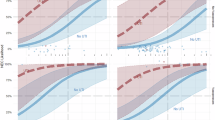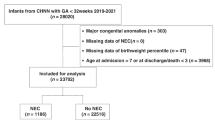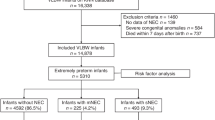Abstract
Background
The aim was to clarify whether children born preterm with a history of necrotizing enterocolitis (NEC) had an increased risk of rickets, fractures, and/or vitamin D deficiency during childhood and adolescence compared to controls without NEC, matched for gestational age.
Methods
All infants born in Sweden between 1987 and 2009 with a gestational age <32 + 0 weeks and a diagnosis of NEC were identified. Totally, 465 children with a history of NEC and 2127 controls were included. International Classification of Diseases codes for all categories of fractures, rickets, vitamin D deficiency, and malnutrition were analyzed.
Results
In total, 94 of the 465 children with NEC died within 28 days. Of the 2127 controls, 288 died within 28 days. Among the remaining 371 NEC cases, 39 fracture occasions were identified. The 1839 controls had 204 fracture occasions. There was no significant difference in fractures. Rickets was diagnosed in 11 (3%) of the children with a history of NEC compared to 21 (1%) of the controls (odds ratio 2.65, 95% CI 1.26–5.53, p = 0.007).
Conclusions
This study showed an increased risk of rickets but not fractures during childhood and adolescence in children born preterm and with a history of NEC, compared to matched controls.
Similar content being viewed by others
Log in or create a free account to read this content
Gain free access to this article, as well as selected content from this journal and more on nature.com
or
References
Rojas, S. et al. Abdominal pathology requiring laparotomy in very preterm infants is associated with need for surgical closure of patent ductus arteriosus. J. Pediatr. Surg. 46, 1898–1902 (2011).
Ahle, M., Drott, P. & Andersson, R. E. Epidemiology and trends of necrotizing enterocolitis in Sweden: 1987-2009. Pediatrics 132, e443–e451 (2013).
Papillon, S. et al. Necrotizing enterocolitis: contemporary management and outcomes. Adv. Pediatr. 60, 263–279 (2013).
Niemarkt, H. J. et al. Necrotizing enterocolitis: a clinical review on diagnostic biomarkers and the role of the intestinal microbiota. Inflamm. Bowel Dis. 21, 436–444 (2015).
Lim, J. C., Golden, J. M. & Ford, H. R. Pathogenesis of neonatal necrotizing enterocolitis. Pediatr. Surg. Int. 31, 509–518 (2015).
Stoll, B. J. et al. Neonatal outcomes of extremely preterm infants from the NICHD Neonatal Research Network. Pediatrics 126, 443–456 (2010).
Yee, W. H. et al. Incidence and timing of presentation of necrotizing enterocolitis in preterm infants. Pediatrics 129, e298–e304 (2012).
Guillet, R. et al. Association of H2-blocker therapy and higher incidence of necrotizing enterocolitis in very low birth weight infants. Pediatrics 117, e137–e142 (2006).
Fellman, V. et al. One-year survival of extremely preterm infants after active perinatal care in Sweden. JAMA 301, 2225–2233 (2009).
Magnusson, A. et al. Population-based study showed that necrotising enterocolitis occurred in space-time clusters with a decreasing secular trend in Sweden. Acta Paediatr. 106, 1097–1102 (2017).
Neu, J. & Walker, W. A. Necrotizing enterocolitis. New Engl. J. Med. 364, 255–264 (2011).
Eaton, S., Rees, C. M. & Hall, N. J. Current research in necrotizing enterocolitis. Early Hum. Dev. 97, 33–39 (2016).
Berman, L. & Moss, R. L. Necrotizing enterocolitis: an update. Semin. Fetal Neonatal Med. 16, 145–150 (2011).
Sharma, R. & Hudak, M. L. A clinical perspective of necrotizing enterocolitis: past, present, and future. Clin. Perinatol. 40, 27–51 (2013).
Pironi, L. Definitions of intestinal failure and the short bowel syndrome. Best. Pract. Res. Clin. Gastroenterol. 30, 173–185 (2016).
Vanderhoof, J. A. & Langnas, A. N. Short-bowel syndrome in children and adults. Gastroenterology 113, 1767–1778 (1997).
Cakir, M. et al. Necrotizing enterocolitis increases the bone resorption in premature infants. Early Hum. Dev. 82, 405–409 (2006).
Harrison, C. M. & Gibson, A. T. Osteopenia in preterm infants. Arch. Dis. Child Fetal Neonatal Ed. 98, F272–F275 (2013).
Harrison, C. M., Johnson, K. & McKechnie, E. Osteopenia of prematurity: a national survey and review of practice. Acta Paediatr. 97, 407–413 (2008).
Dabezies, E. J. & Warren, P. D. Fractures in very low birth weight infants with rickets. Clin. Orthop. Relat. Res. 335, 233–239 (1997).
Abrams, S. A. Calcium and vitamin D requirements of enterally fed preterm infants. Pediatrics 131, e1676–e1683 (2013).
Carpenter, T. O. et al. Rickets. Nat. Rev. Dis. Prim. 3, 17101 (2017).
Chin, L. K. et al. Outcomes of standardised approach to metabolic bone disease of prematurity. J. Paediatr. Child Health 54, 665–670 (2018).
Dokos, C. et al. Inside the “fragile” infant: pathophysiology, molecular background, risk factors and investigation of neonatal osteopenia. Clin. Cases Miner. Bone Metab. 10, 86–90 (2013).
Kanis, J. A. et al. International variations in hip fracture probabilities: implications for risk assessment. J. Bone Min. Res. 17, 1237–1244 (2002).
Heaney, R. P. et al. Peak bone mass. Osteoporos. Int. 11, 985–1009 (2000).
Tsai, J. R. & Yang, P. H. Rickets of premature infants induced by calcium deficiency. A case report. Chang. Yi Xue Za Zhi 20, 142–147 (1997).
Mimouni, F. B. et al. Calcium, phosphorus, magnesium and vitamin D requirements of the preterm infant. World Rev. Nutr. Diet. 110, 140–151 (2014).
Jensen, M. et al. Difficulty achieving vitamin D sufficiency with high-dose oral repletion therapy in infants with cholestasis. J. Pediatr. Gastroenterol. Nutr. 61, 187–189 (2015).
Rohana, J., Hasmawati, J. & Zulkifli, S. Z. Risk factors associated with low bone mineral content in very low birth weight infants. Singap. Med J. 48, 191–194 (2007).
Wharton, B. & Bishop, N. Rickets. Lancet 362, 1389–1400 (2003).
Congdon, P. J. et al. Spontaneous resolution of bone mineral depletion in preterm infants. Arch. Dis. Child. 65(10 Spec No), 1038–1042 (1990).
Pittard, W. B. et al. Longitudinal changes in the bone mineral content of term and premature infants. Am. J. Dis. Child. 144, 36–40 (1990).
Rubinacci, A. et al. Is there an impact of birth weight and early life nutrition on bone mineral content in preterm born infants and children? Acta Paediatr. 82, 711–713 (1993).
StataCorp. Stata Statistical Software: Release 15 (StataCorp LLC, College Station, TX, 2017).
Stigson, L. et al. Bone and fat mass in relation to postnatal levels of insulin-like growth factors in prematurely born children at 4y of age. Pediatr. Res. 75, 544–550 (2014).
Cikrit, D. et al. Long-term follow-up after surgical management of necrotizing enterocolitis: sixty-three cases. J. Pediatr. Surg. 21, 533–535 (1986).
Kelly, A., Kovatch, K. J. & Garber, S. J. Metabolic bone disease screening practices among U.S. neonatologists. Clin. Pediatr. (Philos.) 53, 1077–1083 (2014).
Elfvin, A. et al. Low birthweight, gestational age, need for surgical intervention and gram-negative bacteraemia predict intestinal failure following necrotising enterocolitis. Acta Paediatr. 104, 771–776 (2015).
Acknowledgements
This study was financed by grants from the Swedish state under the agreement between the Swedish government and the county councils, the ALF-agreement (797211, 727721, 716831 and 678871), and financial support by research grants from the Gothenburg medical society and from the Queen Silvia Children’s hospital research foundation.
Author information
Authors and Affiliations
Contributions
A.M.: Conception and design of the study, acquisition of data and analysis and interpretation of data, drafting the article and revising it critically, and final approval of the version to be published. M.A. and R.E.A.: Conception and design of the study, acquisition of data and analysis and interpretation of data, revising the article critically for important intellectual content, and final approval of the version to be published. D.S.-E.: Conception and design of the study, analysis and interpretation of data, revising the article critically for important intellectual content, and final approval of the version to be published. A.E.: Conception and design of the study, analysis and interpretation of data, drafting the article and revising it critically, and final approval of the version to be published.
Corresponding author
Ethics declarations
Competing interests
The authors declare no competing interests.
Additional information
Publisher’s note: Springer Nature remains neutral with regard to jurisdictional claims in published maps and institutional affiliations.
Rights and permissions
About this article
Cite this article
Magnusson, A., Ahle, M., Andersson, R.E. et al. Increased risk of rickets but not fractures during childhood and adolescence following necrotizing enterocolitis among children born preterm in Sweden. Pediatr Res 86, 100–106 (2019). https://doi.org/10.1038/s41390-019-0390-z
Received:
Revised:
Accepted:
Published:
Issue date:
DOI: https://doi.org/10.1038/s41390-019-0390-z
This article is cited by
-
Nutritional management after necrotizing enterocolitis and focal intestinal perforation in preterm infants
Pediatric Research (2024)
-
Body composition and bone mass among 5-year-old survivors of necrotizing enterocolitis
Pediatric Research (2023)
-
Establishment of a nomogram model for predicting metabolic bone disease in preterm infants: A case‒control study
European Journal of Pediatrics (2023)



